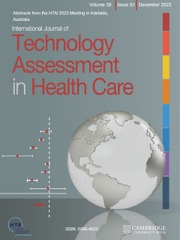Crossref Citations
This article has been cited by the following publications. This list is generated based on data provided by
Crossref.
Falissard, Bruno
Zylberman, Myriam
Cucherat, Michel
Izard, Valérie
Meyer, François
Barna, Alexandre
Cucherat, Michel
De Bels, Frédéric
de Sahb, Rima
Delonca, Jean
Izard, Valérie
Jolliet, Pascale
Joubert, Jean-Michel
Launois, Robert
Le Jeunne, Claire
Lièvre, Michel
Gaudin, Florence Mahlberg
Moser, Aurélie
Perles, Patricia
Pigeon, Martine
Coquais, Cécile Rey
Weisslinger, Nadine
and
Xerri, Bertrand
2009.
Real Medical Benefit Assessed by Indirect Comparison.
Therapies,
Vol. 64,
Issue. 3,
p.
229.
Falissard, Bruno
Zylberman, Myriam
Cucherat, Michel
Izard, Valérie
Meyer, François
Barna, Alexandre
Cucherat, Michel
De Bels, Frédéric
de Sahb, Rima
Delonca, Jean
Izard, Valérie
Jolliet, Pascale
Joubert, Jean-Michel
Launois, Robert
Le Jeunne, Claire
Lièvre, Michel
Gaudin, Florence Mahlberg
Moser, Aurélie
Perles, Patricia
Pigeon, Martine
Coquais, Cécile Rey
Weisslinger, Nadine
and
Xerri, Bertrand
2009.
Bénéfice médical réel estimé par comparaisons indirectes.
Therapies,
Vol. 64,
Issue. 3,
p.
225.
Uthman, Olalekan A.
and
Yahaya, Ismail
2010.
Meta-Analysis of Randomized Controlled Trials on the Treatment of Pulmonary Arterial Hypertension.
Circulation Journal,
Vol. 74,
Issue. 11,
p.
2503.
Eichler, Hans-Georg
Bloechl-Daum, Brigitte
Abadie, Eric
Barnett, David
König, Franz
and
Pearson, Steven
2010.
Relative efficacy of drugs: an emerging issue between regulatory agencies and third-party payers.
Nature Reviews Drug Discovery,
Vol. 9,
Issue. 4,
p.
277.
Verdian, Lara
and
Yi, Yunni
2010.
Cost-utility analysis of rufinamide versus topiramate and lamotrigine for the treatment of children with Lennox–Gastaut Syndrome in the United Kingdom.
Seizure,
Vol. 19,
Issue. 1,
p.
1.
Lange, Stefan
and
Thomas, Stefanie
2010.
Anforderungen an die Evidenz für Systementscheidungen zur Aufnahme medizinischer Maßnahmen in den Leistungskatalog der Gesetzlichen Krankenversicherung.
Zeitschrift für Evidenz, Fortbildung und Qualität im Gesundheitswesen,
Vol. 104,
Issue. 8-9,
p.
642.
Coory, Michael
and
Jordan, Susan
2010.
Frequency of Treatment-Effect Modification Affecting Indirect Comparisons.
PharmacoEconomics,
Vol. 28,
Issue. 9,
p.
723.
van Geijlswijk, Ingeborg M.
Korzilius, Hubert P. L. M.
and
Smits, Marcel G.
2010.
The Use of Exogenous Melatonin in Delayed Sleep Phase Disorder: A Meta-analysis.
Sleep,
Vol. 33,
Issue. 12,
p.
1605.
Di Lorenzo, Giuseppe
Casciano, Roman
Malangone, Elisabetta
Buonerba, Carlo
Sherman, Steven
Willet, Jacob
Wang, Xufang
Liu, Zhimei
and
De Placido, Sabino
2011.
An adjusted indirect comparison of everolimus and sorafenib therapy in sunitinib-refractory metastatic renal cell carcinoma patients using repeated matched samples.
Expert Opinion on Pharmacotherapy,
Vol. 12,
Issue. 10,
p.
1491.
Naci, Huseyin
and
Fleurence, Rachael
2011.
Using Indirect Evidence to Determine the Comparative Effectiveness of Prescription Drugs: Do Benefits Outweigh Risks?.
Health Outcomes Research in Medicine,
Vol. 2,
Issue. 4,
p.
e241.
Casciano, Roman
Chulikavit, Maruit
Di Lorenzo, Giuseppe
Liu, Zhimei
Baladi, Jean-Francois
Wang, Xufang
Robertson, Justin
and
Garrison, Lou
2011.
Economic Evaluation of Everolimus versus Sorafenib for the Treatment of Metastatic Renal Cell Carcinoma after Failure of First-Line Sunitinib.
Value in Health,
Vol. 14,
Issue. 6,
p.
846.
van Luijn, JCF
Danz, M
Bijlsma, JWJ
Gribnau, FWJ
and
Leufkens, HGM
2011.
Post-approval trials of new medicines: widening use or deepening knowledge? Analysis of 10 years of etanercept.
Scandinavian Journal of Rheumatology,
Vol. 40,
Issue. 3,
p.
183.
CHANG, John Wen‐Cheng
THONGPRASERT, Sumitra
WRIGHT, Elaine
TSANG, Kenneth
KIM, Heung Tae
AHN, Myung‐Ju
KIM, Joo‐Hang
KANG, Jin Hyoung
KIM, Sang‐We
and
WALZER, Stefan
2011.
An indirect comparison of bevacizumab plus cisplatin‐gemcitabine and cisplatin plus pemetrexed treatment for patients with advanced first‐line non‐squamous non‐small cell lung cancer in East Asia.
Asia-Pacific Journal of Clinical Oncology,
Vol. 7,
Issue. s2,
p.
13.
Song, Fujian
Clark, Allan
Bachmann, Max O
and
Maas, Jim
2012.
Simulation evaluation of statistical properties of methods for indirect and mixed treatment comparisons.
BMC Medical Research Methodology,
Vol. 12,
Issue. 1,
Berlin, Jesse A.
Cepeda, Soledad
and
Kim, Carin J.
2012.
Pharmacoepidemiology.
p.
723.
Higgins, J. P. T.
Jackson, D
Barrett, J. K.
Lu, G
Ades, A. E.
and
White, I. R.
2012.
Consistency and inconsistency in network meta‐analysis: concepts and models for multi‐arm studies.
Research Synthesis Methods,
Vol. 3,
Issue. 2,
p.
98.
Gaultney, Jennifer G
Redekop, William K
Sonneveld, Pieter
and
Uyl-de Groot, Carin A
2012.
Novel anticancer agents for multiple myeloma: a review of the evidence for their therapeutic and economic value.
Expert Review of Anticancer Therapy,
Vol. 12,
Issue. 6,
p.
839.
McDonagh, Marian S
Jonas, Daniel E
Gartlehner, Gerald
Little, Alison
Peterson, Kim
Carson, Susan
Gibson, Mark
and
Helfand, Mark
2012.
Methods for the Drug Effectiveness Review Project.
BMC Medical Research Methodology,
Vol. 12,
Issue. 1,
Soto Álvarez, Javier
2012.
Evaluación económica de medicamentos y tecnologías sanitarias:.
p.
75.
Baker, William L.
and
Phung, Olivia J.
2012.
Systematic Review and Adjusted Indirect Comparison Meta-Analysis of Oral Anticoagulants in Atrial Fibrillation.
Circulation: Cardiovascular Quality and Outcomes,
Vol. 5,
Issue. 5,
p.
711.

